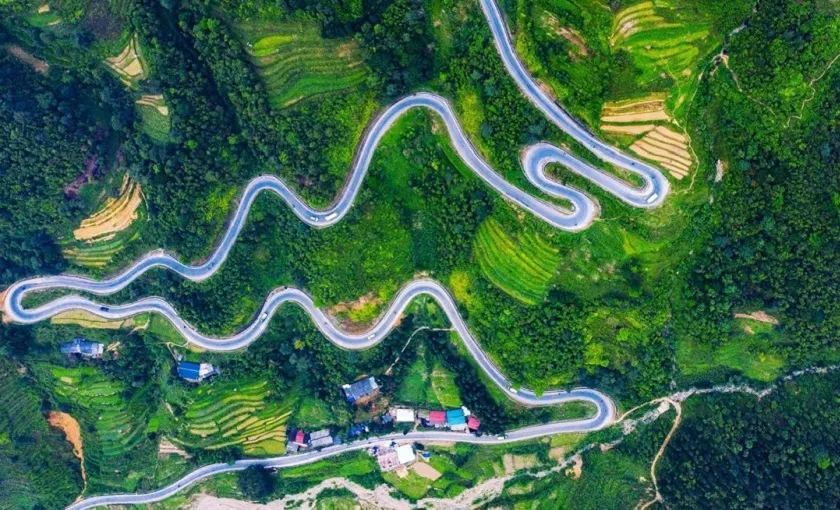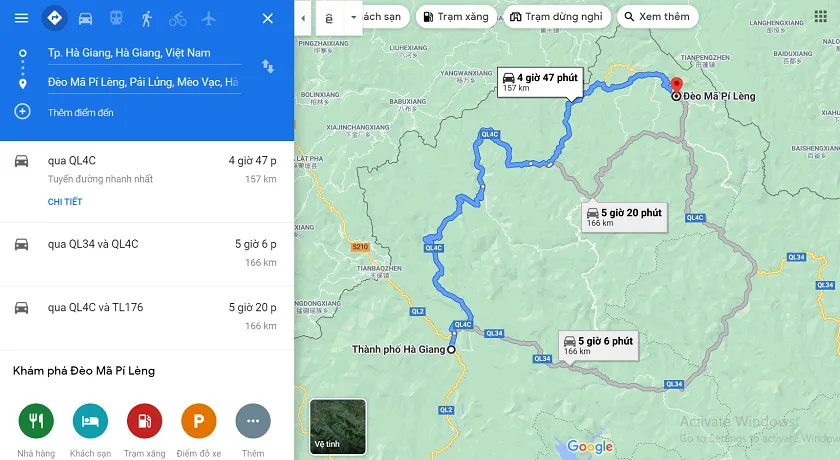Ma Pi Leng Pass, a name that evokes majesty and danger, has long been a symbol of Ha Giang tourism and one of the legendary “four great passes” of Vietnam. More than just the most beautiful mountain pass, Ma Pi Leng holds profound historical and cultural stories and offers a unique conquering experience for anyone passionate about exploration. Let “Du lịch khắp thế gian” (Travel Around the World) guide you to witness the beauty of Ma Pi Leng and gather the most useful travel tips for your journey.
Discovering Ma Pi Leng Pass: The Legend of the “Horse’s Nose Bridge”
Geographical Location and Meaning of the Name
Ma Pi Leng Pass is located on the Happiness Road, the vital route connecting Ha Giang city with the two highland districts of Dong Van and Meo Vac. The name “Ma Pi Leng” in the Quan Hoa language means “horse’s nose bridge,” a vivid metaphor to describe the steep slopes and treacherousness of the pass. Seen from afar, the pass winds like a horse’s spine between sharp cat-ear rocky mountains, further enhancing the wild beauty and challenge of this place.
The Arduous History of Building Happiness Road
Few people know that the Ma Pi Leng Pass we see today is the result of an arduous and sacrificial construction process. Happiness Road, including Ma Pi Leng Pass, began construction in 1959 and was completed in 1965. More than 2,000 laborers from 16 ethnic groups of 8 northern provinces participated in this monumental project. In particular, the Ma Pi Leng Pass section was constructed by suicide youth volunteer teams. They hung themselves on vertical cliffs, working with the most rudimentary tools to chisel rocks and open roads for nearly a year.
The sacrifice and courageous spirit of the road openers transformed the impossible into reality, creating Happiness Road and the legendary Ma Pi Leng Pass. Today, when setting foot here, every visitor not only admires the natural beauty but also feels the historical value and great contributions of previous generations.
Cultural and Tourist Value
Ma Pi Leng Pass is not only a natural wonder but also an inseparable part of the culture and spiritual life of the highland people of Ha Giang. The pass is a historical witness, marking the pioneering and construction footsteps of the local ethnic communities.
In terms of tourism, Ma Pi Leng plays an extremely important role. This pass road is an unmissable destination on the journey to explore the Dong Van Karst Plateau Geopark, attracting thousands of tourists every year. Coming to Ma Pi Leng, visitors not only admire the majestic natural scenery but also have the opportunity to experience the unique culture of ethnic minorities, explore villages hidden in the rocky mountains, and enjoy the unique cuisine of the highlands.

Experiencing the Conquest of Ma Pi Leng Pass: Vietnam’s Most Beautiful Road
Winding Roads and “Challenging” Curves
The journey to conquer Ma Pi Leng Pass is truly a memorable and challenging experience. The pass road is about 20km long with 9 consecutive winding curves. On one side are high, vertical cliffs, towering like fortresses, and on the other side is the deep abyss of Tu San Canyon. Each curve is a “heart-stopping” moment, requiring drivers to have steady steering and high concentration.
However, it is precisely the ruggedness and challenge that create the special attraction of Ma Pi Leng. Overcoming hairpin bends and winding slopes, visitors will feel small before the majestic nature, and at the same time, appreciate the values they have achieved.
Admiring the Majestic Panorama from the Pass Summit
After moments of “holding your breath” while crossing the pass, the reward for visitors is the spectacular natural scenery from the summit of Ma Pi Leng. Standing on the pass summit, looking into the distance, you will be overwhelmed by the panoramic view of overlapping mountains, gray limestone ranges hidden in the misty haze. Below is the emerald green Nho Que River winding like a soft silk strip, embracing the deep Tu San Canyon.
The beauty of Ma Pi Leng changes at different times of the day and seasons of the year. In the early morning, when dawn breaks, the whole space is covered with gentle golden sunlight, creating a romantic and poetic scene. In the late afternoon, the sunset descends, dyeing the sky red, bringing a beauty of serenity and mystery. No matter when you come to Ma Pi Leng, this place will amaze and captivate you.
Beautiful Check-in Spots on Ma Pi Leng Pass
Ma Pi Leng is not just a pass road, but also a “paradise” check-in spot for virtual living enthusiasts. Along the pass, there are many ideal stops for you to admire the scenery and take souvenir photos.
- Chin Khoanh Slope (Nine Twists Slope): One of the most famous and dangerous slopes on Ma Pi Leng Pass. Standing from above looking down, Chin Khoanh Slope winds like a giant snake, creating a very impressive scene.
- Virtual living rock outcrops: Rock outcrops protruding from the cliffs, with panoramic views of Ma Pi Leng Pass and Tu San Canyon, are popular check-in spots for many tourists.
- Ma Pi Leng Observatory: Here, you can get the most panoramic and comprehensive view of Ma Pi Leng Pass, Nho Que River, and Tu San Canyon.
- Coffee shops on the pass: Enjoying a hot cup of coffee while admiring the majestic Ma Pi Leng Pass is a wonderful experience that you should not miss.

Exploring the Nho Que River and Tu San Canyon
At the foot of Ma Pi Leng Pass is the jade-green Nho Que River and the majestic Tu San Canyon. The Nho Que River is likened to a soft “green silk strip” winding through gray rocky mountains, creating a beautiful ink painting. Tu San Canyon is known as the “most magnificent wonder” of the Dong Van Karst Plateau Geopark, with vertical cliffs hundreds of meters high, towering between heaven and earth.
Visitors can experience boating on the Nho Que River to explore Tu San Canyon from a completely different perspective. Sitting on a boat, gliding gently on the clear blue water, looking up at the towering cliffs, you will feel very small before the majesty of nature.
Ma Pi Leng Pass Travel Tips: A to Z Guide
Ideal Time to Travel
The best time to travel to Ma Pi Leng Pass is during the dry season, from October to April of the following year. At this time, Ha Giang weather is dry, with little rain, and clear skies, which is very convenient for traveling and sightseeing. Especially, around October – November, buckwheat flowers bloom all over the karst plateau, creating an extremely romantic and poetic scene.
Summer (from May to September) is also a suitable time to travel to Ma Pi Leng if you want to experience the cool and fresh atmosphere of the highlands. However, in the summer, Ha Giang often has showers, so you should follow the weather forecast before going and prepare raincoats and umbrellas fully.
Means of Transport
To get to Ma Pi Leng Pass, you can choose to travel by motorbike or car.
- Motorbike: Motorbike is the vehicle chosen by many tourists to conquer Ma Pi Leng Pass, especially young people who like to explore and experience. Traveling by motorbike helps you be proactive about time and schedule, and you can stop anywhere to admire the scenery and take photos. However, Ma Pi Leng Pass road is quite dangerous, you need to have steady steering and experience driving on mountain passes.
- Car: If you travel in a large group or are not confident in your driving skills, a car is a safer and more comfortable choice. You can rent a tourist car or a passenger car to get to Ma Pi Leng. However, traveling by car will be less flexible than by motorbike, and you may miss some beautiful scenery along the way.

Accommodation and Cuisine
Right on Ma Pi Leng Pass, there are some homestays and small guesthouses serving tourists, the most famous of which is Ma Pi Leng Homestay. However, the number of accommodations in the pass area is limited, especially during the peak tourist season. Many tourists often choose to stay in Dong Van or Meo Vac town, and then travel to Ma Pi Leng during the day.
Regarding cuisine, when coming to Ma Pi Leng and the Dong Van, Meo Vac area, you should not miss the opportunity to enjoy famous Ha Giang specialties such as: Thang Co (horse meat hotpot), Men Men (steamed corn flour), Chao Au Tau (Au Tau porridge), Banh Cuon Trung (egg rice rolls), Thit Trau Gac Bep (smoked buffalo meat), Lap Xuong (Vietnamese sausage), mint honey, etc.
Important Notes When Conquering the Pass
- Check the vehicle carefully: If you travel by motorbike, check the vehicle carefully before going, especially the brake system, tires, and headlights.
- Steady steering: Ma Pi Leng Pass has many dangerous curves, only for people with steady steering and experience driving on mountain passes. If you are not confident, hire a motorbike taxi or easy rider to ensure safety.
- Keep a slow speed and focus: When driving on the pass, keep a slow speed, stay in your lane, and always concentrate highly. Limit using your phone or doing things that distract you while driving.
- Prepare appropriate clothing: The weather in the Ha Giang highlands is quite cold, especially in the evening and early morning. You should prepare warm clothes, gloves, scarves, and woolen hats to keep your body warm.
- Bring personal identification: When traveling to Ha Giang, you should bring personal identification (ID card or passport) to complete procedures for renting vehicles, booking hotel rooms, and other necessary procedures.
- Respect local culture: Ha Giang is a multi-ethnic region, you should respect the customs, habits, and culture of the local people.
Conclusion: Ma Pi Leng – An Unmissable Destination in Ha Giang
Ma Pi Leng Pass is not only a beautiful pass road but also a symbol of the power of conquest and the majestic beauty of Vietnamese nature. The journey to explore Ma Pi Leng will bring you unforgettable experiences, from the thrill of overcoming dangerous curves to the awe of the magnificent beauty of mountains and rivers. If you are a lover of adventure travel and want to seek new experiences, come to Ma Pi Leng and feel the legendary beauty of Vietnam’s “four great passes.”